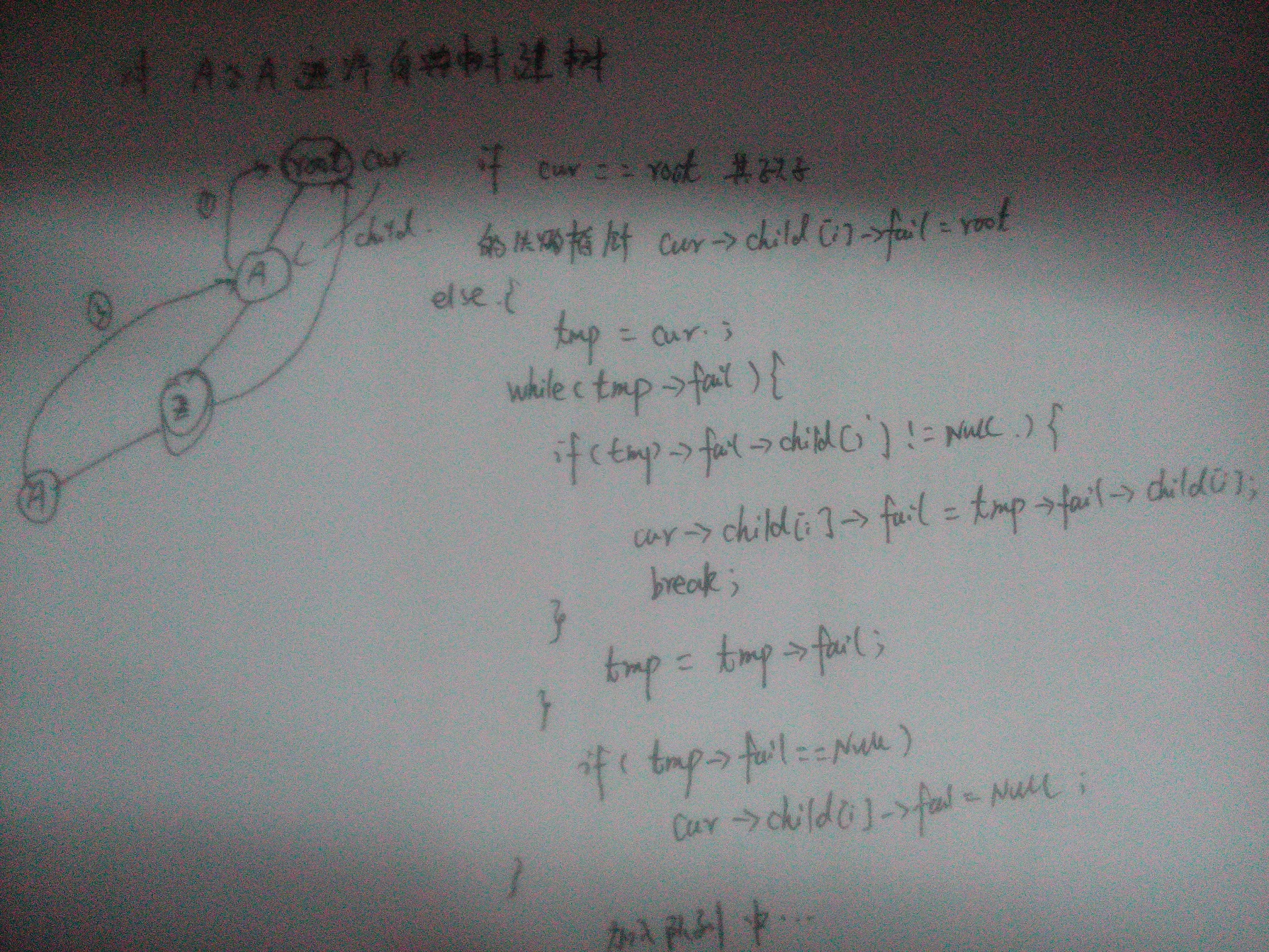Oulipo
Time Limit: 3000/1000 MS (Java/Others) Memory Limit: 32768/32768 K (Java/Others)
Total Submission(s): 6227 Accepted Submission(s):
2513
Problem Description
The French author Georges Perec (1936–1982) once wrote
a book, La disparition, without the letter 'e'. He was a member of the Oulipo
group. A quote from the book:
Tout avait Pair normal, mais tout s’affirmait faux. Tout avait Fair normal, d’abord, puis surgissait l’inhumain, l’affolant. Il aurait voulu savoir où s’articulait l’association qui l’unissait au roman : stir son tapis, assaillant à tout instant son imagination, l’intuition d’un tabou, la vision d’un mal obscur, d’un quoi vacant, d’un non-dit : la vision, l’avision d’un oubli commandant tout, où s’abolissait la raison : tout avait l’air normal mais…
Perec would probably have scored high (or rather, low) in the following contest. People are asked to write a perhaps even meaningful text on some subject with as few occurrences of a given “word” as possible. Our task is to provide the jury with a program that counts these occurrences, in order to obtain a ranking of the competitors. These competitors often write very long texts with nonsense meaning; a sequence of 500,000 consecutive 'T's is not unusual. And they never use spaces.
So we want to quickly find out how often a word, i.e., a given string, occurs in a text. More formally: given the alphabet {'A', 'B', 'C', …, 'Z'} and two finite strings over that alphabet, a word W and a text T, count the number of occurrences of W in T. All the consecutive characters of W must exactly match consecutive characters of T. Occurrences may overlap.
Tout avait Pair normal, mais tout s’affirmait faux. Tout avait Fair normal, d’abord, puis surgissait l’inhumain, l’affolant. Il aurait voulu savoir où s’articulait l’association qui l’unissait au roman : stir son tapis, assaillant à tout instant son imagination, l’intuition d’un tabou, la vision d’un mal obscur, d’un quoi vacant, d’un non-dit : la vision, l’avision d’un oubli commandant tout, où s’abolissait la raison : tout avait l’air normal mais…
Perec would probably have scored high (or rather, low) in the following contest. People are asked to write a perhaps even meaningful text on some subject with as few occurrences of a given “word” as possible. Our task is to provide the jury with a program that counts these occurrences, in order to obtain a ranking of the competitors. These competitors often write very long texts with nonsense meaning; a sequence of 500,000 consecutive 'T's is not unusual. And they never use spaces.
So we want to quickly find out how often a word, i.e., a given string, occurs in a text. More formally: given the alphabet {'A', 'B', 'C', …, 'Z'} and two finite strings over that alphabet, a word W and a text T, count the number of occurrences of W in T. All the consecutive characters of W must exactly match consecutive characters of T. Occurrences may overlap.
Input
The first line of the input file contains a single
number: the number of test cases to follow. Each test case has the following
format:
One line with the word W, a string over {'A', 'B', 'C', …, 'Z'}, with 1 ≤ |W| ≤ 10,000 (here |W| denotes the length of the string W).
One line with the text T, a string over {'A', 'B', 'C', …, 'Z'}, with |W| ≤ |T| ≤ 1,000,000.
One line with the word W, a string over {'A', 'B', 'C', …, 'Z'}, with 1 ≤ |W| ≤ 10,000 (here |W| denotes the length of the string W).
One line with the text T, a string over {'A', 'B', 'C', …, 'Z'}, with |W| ≤ |T| ≤ 1,000,000.
Output
For every test case in the input file, the output
should contain a single number, on a single line: the number of occurrences of
the word W in the text T.
Sample Input
3
BAPC
BAPC
AZA
AZAZAZA
VERDI
AVERDXIVYERDIAN
Sample Output
1
3
0
Source
ac自动机做法:

代码:
1 #include<stdio.h> 2 #include<stdlib.h> 3 #include<string.h> 4 #include<iostream> 5 #include<queue> 6 7 using namespace std; 8 const int maxn=26; 9 10 struct node{ 11 12 node *child[maxn]; 13 node * fail ; //失败指针 14 int tail ; 15 16 }; 17 void init(node * tmp){ 18 for(int i=0;i<maxn;i++) 19 tmp->child[i]=NULL; 20 tmp->fail=NULL; 21 tmp->tail=0; 22 } 23 24 25 //建立一颗字典树 26 27 void Buildtree(const char ss [] ,node * root){ 28 node *cur; 29 for(int i=0; ss[i] ; i++){ 30 int no =ss[i]-'A'; 31 if(root->child[no]==NULL){ 32 cur = new node ; 33 init(cur); 34 root->child[no]=cur; 35 } 36 root = root->child[no]; 37 } 38 root->tail++; 39 } 40 41 //构造失败指针 42 void BuildFail(node * root){ 43 44 queue<node *> tmp; 45 tmp.push(root); 46 node *cur,*po; 47 while(!tmp.empty()){ 48 cur = tmp.front(); 49 tmp.pop(); //出队列 50 for(int i=0 ; i<maxn ; i++){ 51 if( cur->child[i] != NULL ){ 52 if(cur==root){ 53 cur->child[i]->fail=root; //指向树根 54 }else{ 55 po = cur ; 56 while(po->fail){ 57 if(po->fail->child[i]){ 58 cur->child[i]->fail=po->fail->child[i]; 59 break; 60 } 61 po = po->fail; 62 } 63 if(po->fail==NULL) 64 cur->child[i]->fail=root; 65 } 66 tmp.push(cur->child[i]); 67 } 68 } 69 } 70 } 71 72 //查询 73 int Query(char ss [] , node *root){ 74 75 node *cur , *tmp; 76 cur =root; 77 int pos=-1,res=0; 78 79 for(int i=0; ss[i] ;i++){ 80 81 pos= ss[i]-'A'; 82 while(cur->child[pos]==NULL&&cur!=root) 83 cur = cur->fail; 84 cur = cur->child[pos]; 85 if(cur==NULL) cur=root; 86 tmp = cur; 87 while(tmp!=root&&tmp->tail>0){ 88 res+=tmp->tail; 89 tmp = tmp->fail; 90 } 91 } 92 93 return res; 94 95 } 96 char sa[10010],sb[1000010]; 97 int main(){ 98 int te; 99 node *root; 100 scanf("%d",&te); 101 while(te--){ 102 root = new node ; 103 init(root); 104 scanf("%s %s",sa,sb); 105 Buildtree(sa,root); 106 BuildFail(root); 107 int ans =Query(sb,root); 108 printf("%d ",ans); 109 } 110 return 0; 111 }